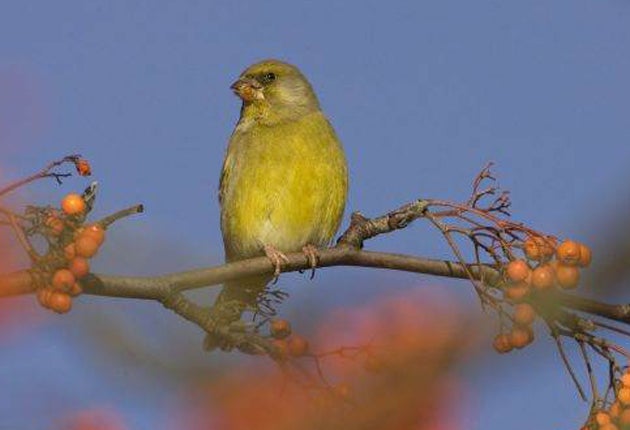Pigeon disease kills one in three greenfinches

Your support helps us to tell the story
From reproductive rights to climate change to Big Tech, The Independent is on the ground when the story is developing. Whether it's investigating the financials of Elon Musk's pro-Trump PAC or producing our latest documentary, 'The A Word', which shines a light on the American women fighting for reproductive rights, we know how important it is to parse out the facts from the messaging.
At such a critical moment in US history, we need reporters on the ground. Your donation allows us to keep sending journalists to speak to both sides of the story.
The Independent is trusted by Americans across the entire political spectrum. And unlike many other quality news outlets, we choose not to lock Americans out of our reporting and analysis with paywalls. We believe quality journalism should be available to everyone, paid for by those who can afford it.
Your support makes all the difference.Populations of greenfinches, among Britain's most handsome and popular garden birds, dropped by a third in parts of England within a year of the emergence of a new disease, a new study reports.
Scientists from the Garden Bird Health initiative discovered that greenfinches declined dramatically after trichomonosis, a disease normally associated with pigeons, apparently "jumped the species barrier" and began to affect finches in 2005.
Populations of chaffinches were also hard hit, their numbers falling by up to 20 per cent in some places, and other garden birds were affected.
The cause of the disease is a parasite, Trichomonas gallinae, well known as a cause of disease in pigeons and doves, and in birds of prey that feed on them, but not hitherto in songbirds.
The parasite is vulnerable to dryness and cannot survive for long periods outside its host, so transmission of infection is most likely to be through birds feeding one another with regurgitated food during the breeding season; or through food or drinking water contaminated with saliva.
Outbreaks of trichomonosis are most severe and frequent between August and October, when sick birds tend to stay close to feeders and sources of water, and often die there.
The findings of the study, which is described in a paper published in the online journal PLoS ONE this week, show that most birds died in the summer and autumn months, and that outbreaks of the disease have continued to occur each year since its emergence in 2005.
"These findings demonstrate that virulent infectious diseases can cause sharp population declines in common wild birds in just a short period of time," said Dr Rob Robinson, a principal ecologist at the British Trust for Ornithology and one of the lead authors of the paper.
To determine the scale of the disease outbreak, the study used data drawn from public observation and a volunteer survey. Further data came from post-mortem examinations of hundreds of birds collected from gardens across the country.
"This citizen science project highlights the valuable role that volunteers can play in helping us learn more about wildlife diseases, even by just watching birds in their gardens for a couple of hours each week," said Becki Lawson, a wildlife vet from the Zoological Society of London and another lead author of the study.
The Garden Bird Health initiative was established in 2003 to develop guidelines about how best to feed garden birds so as to maximise the benefits in terms of their conservation and welfare.
James Kirkwood, chief executive of the Universities Federation for Animal Welfare and founder of the initiative commented: "Health surveillance of British wildlife species is crucial for us to recognise new and emerging disease threats that not only adversely affect the welfare of individual animals, but have the potential to impact entire populations."
The Garden Bird Health initiative team is now investigating possible factors underlying the emergence of this disease and its continued impact.
Join our commenting forum
Join thought-provoking conversations, follow other Independent readers and see their replies
Comments